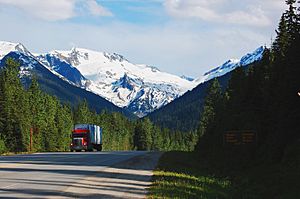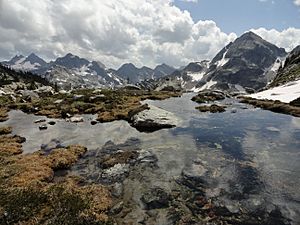Columbia Mountains facts for kids
Quick facts for kids Columbia Mountains |
|
|---|---|
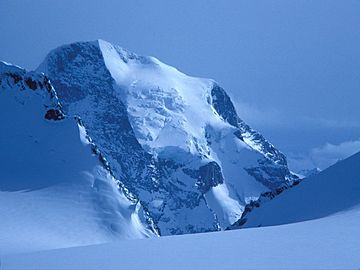
Mount Sir Sandford from the Gothics Glacier
|
|
| Highest point | |
| Peak | Mount Sir Sandford |
| Elevation | 3,519 m (11,545 ft) |
| Dimensions | |
| Length | 741 km (460 mi) N-S |
| Width | 493 km (306 mi) W-E |
| Area | 135,952 km2 (52,491 sq mi) |
| Geography | |
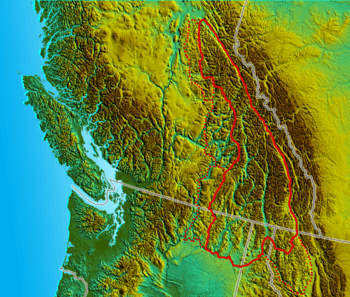
Location map of Columbia Mountains: dotted lines to left mark boundaries of Okanagan, Shuswap and Quesnel Highlands, dotted lines to lower right mark Salish and Cabinet Mountains.
|
|
| Countries | Canada and United States |
| Parent range | North American Cordillera |
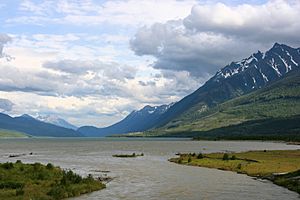
The Columbia Mountains are a large group of mountain ranges. You can find them near the upper part of the Columbia River. This amazing mountain area stretches across parts of British Columbia in Canada. It also goes into Montana, Idaho, and Washington in the United States.
These mountains cover a huge area, about 135,952 square kilometers (52,491 square miles)! Most of the Columbia Mountains, about 75%, are in Canada. The rest, about 25%, are in the United States. The tallest mountain in this range is Mount Sir Sandford. It stands incredibly tall at 3,519 meters (11,545 feet).
Contents
What Are the Main Mountain Ranges?
The Columbia Mountains are not just one big range. They are made up of four main groups of mountains. Each of these groups has many smaller mountain ranges inside them.
- Cariboo Mountains: These are a large part of the Columbia Mountains. They include areas like the Premier Range.
- Monashee Mountains: You can find these mountains to the west of the Selkirk Mountains. They have many smaller ranges, such as the Gold Range.
- Selkirk Mountains: These are very famous for their rugged peaks. The highest mountain in the Columbia Mountains, Mount Sir Sandford, is found here.
- Purcell Mountains: Also known as the Percell Mountains in the US, these are known for their stunning granite spires. The The Bugaboos Group is a well-known part of the Purcells.
Sometimes, lower areas to the west are also considered part of the Columbia Mountains. These include the Quesnel Highland, Shuswap Highland, and Okanagan Highland.
Which Are the Tallest Mountains?
The Columbia Mountains are home to some very high peaks. Here are the ten tallest mountains in this region, from highest to lowest:
- Mount Sir Sandford (3,519 m) - Located in the Selkirk Mountains.
- Mount Sir Wilfrid Laurier (3,516 m) - Found in the Cariboo Mountains.
- Mount Farnham (3,493 m) - Part of the Purcell Mountains.
- Jumbo Mountain (3,437 m) - Also in the Purcell Mountains.
- Howser Spire (3,412 m) - Another tall peak in the Purcell Mountains.
- Mount Delphine (3,406 m) - Located in the Purcell Mountains.
- Mount Sir John Abbott (3,398 m) - Found in the Cariboo Mountains.
- Mount Hammond (3,387 m) - Part of the Purcell Mountains.
- Mount Dawson (3,377 m) - Located in the Selkirk Mountains.
- Eyebrow Peak (3,362 m) - Another peak in the Purcell Mountains.
Important Mountain Passes
Mountain passes are lower areas that allow people to travel through mountains. Here are some important passes in or around the Columbia Mountains:
- Cedarside Pass: This pass connects the Fraser and Columbia Rivers.
- Canal Flats: This pass links the Columbia and Kootenay Rivers.
- Rogers Pass: A famous pass located between the towns of Revelstoke and Golden.
- Kootenay Pass: This pass connects the areas between Trail and Creston.
- Eagle Pass: Found between Revelstoke and Sicamous.
- Monashee Pass: You can find this pass along British Columbia Highway 6.
- Bonanza Pass: This pass connects Christina Lake to Castlegar or Rossland.
Parks and Protected Areas
The Columbia Mountains are home to many beautiful national and provincial parks. These parks help protect the amazing nature and wildlife of the region. Some of these parks include:
- Ansty Hunakwa Protected Area
- Bowron Lake Provincial Park
- Bugaboo Provincial Park
- Cariboo Mountains Provincial Park
- Dunn Peak Protected Area
- Glacier National Park
- Gladstone Provincial Park
- Goat Range Provincial Park
- Granby Provincial Park
- Graystokes Provincial Park
- Kianuko Provincial Park
- Kokanee Glacier Provincial Park
- Monashee Provincial Park
- Mount Revelstoke National Park
- Myra-Bellevue Provincial Park
- Okanagan Mountain Provincial Park
- Purcell Wilderness Conservancy Provincial Park and Protected Area
- St. Mary's Alpine Provincial Park
- Silver Star Provincial Park
- Valhalla Provincial Park
- Wells Grey Provincial Park
- West Arm Provincial Park
- West Twin Provincial Park and Protected Area
See also
 In Spanish: Montañas Columbia para niños
In Spanish: Montañas Columbia para niños


